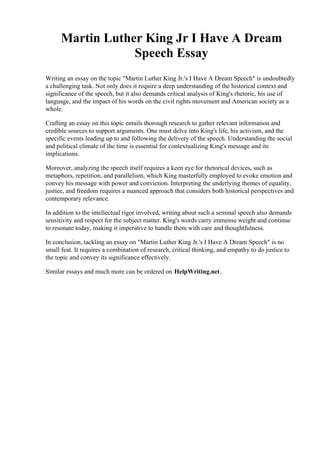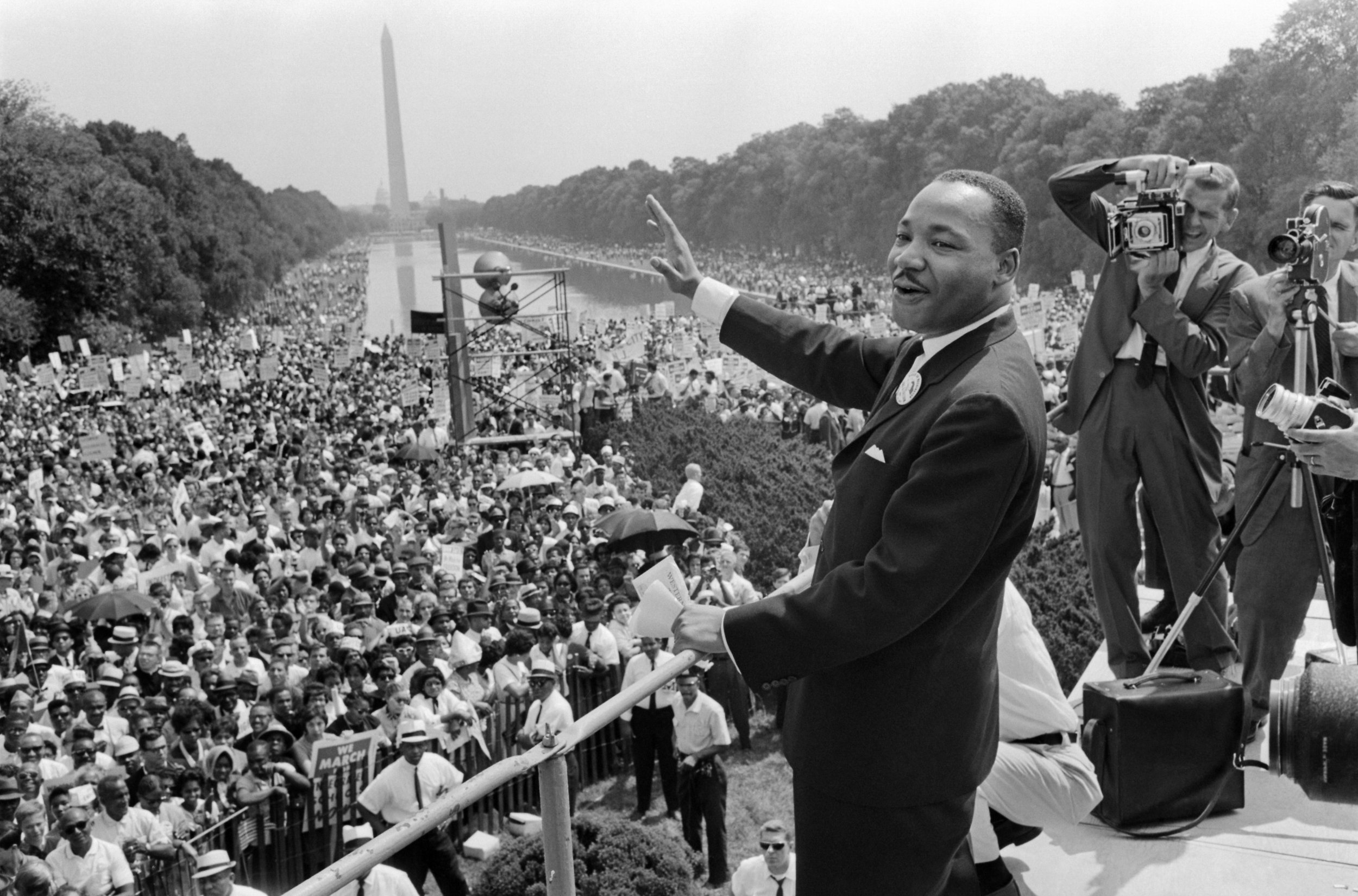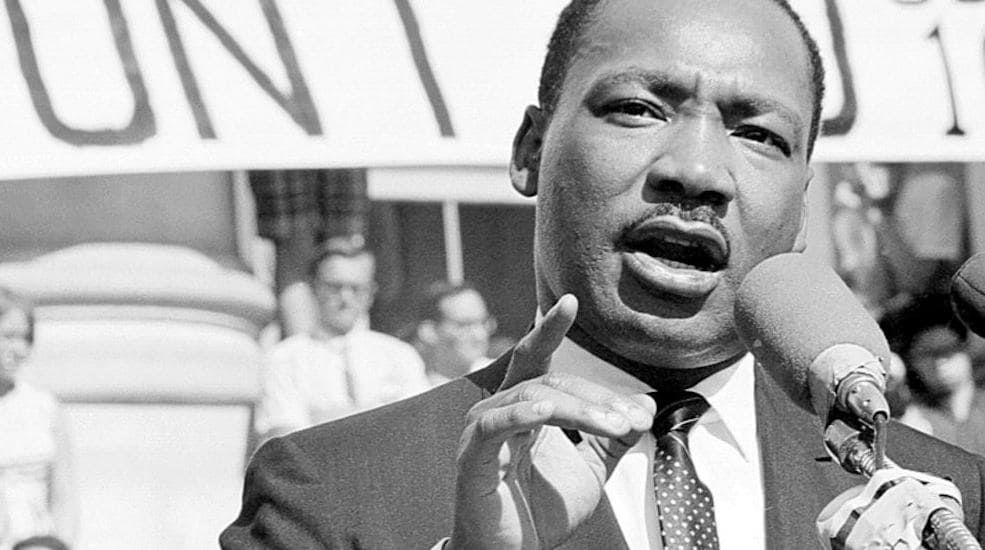Gallery
Photos from events, contest for the best costume, videos from master classes.
 |  |
 |  |
 |  |
 |  |
 |  |
 |
By far the most common metaphors used in the speech are those of nature. Dr. King uses metaphors of mountains, valleys, deserts, oases, stones, solid rocks, quicksand, islands, oceans, waters, streams, wind, whirlwinds, and storms. Dr. King describes an America almost 100 years after the Emancipation Proclamation: Some of the metaphors in Martin Luther King’s “I Have a Dream” speech include “beacon light of hope,” which uses light as a metaphor for hope, and “long night of captivity,” which represents the years of enslavement African-Americans faced. This paper examines the extensive use of metaphors in Martin Luther King's speech, "I Have a Dream", and how metaphors serve as powerful literary devices in political speeches. In this article, we will explore the powerful use of metaphors in Martin Luther King Jr.’s “I Have a Dream” speech. This speech is widely recognized as a masterpiece of American rhetoric, and its use of metaphor is a significant reason for its enduring impact. Dr. Martin Luther King Jr. gave his famous ‘I Have a Dream’ speech at the Lincoln Memorial on August 28, 1963. This speech is remembered for its powerful language and the skillful way King used metaphors to paint a picture of what the Civil Rights Movement was about. In addition to being a speech of immense historical value, Martin Luther King's "I Have a Dream" speech provides brilliant examples of metaphor. "I Have a Dream" speech metaphors include the nation's founding documents, weather, freedom, brotherly love, hatred, oppression and money. Martin Luther King employs various figures of speech, including metaphors, similes, allusions, and references, enriching the language and impact of his speech. Metaphors are particularly prevalent, with examples like “the long night of captivity,” “solid rock of brotherhood,” “a bad check,” “sweltering summer,” and others (554). Metaphor, a common figure of speech, is a comparison of one thing with another: happiness is a sunny day, loneliness is a locked door, coziness is a cat on your lap. This is probably one of Martin Luther King's favorite rhetorical devices. In conclusion, Martin Luther King Jr.'s use of metaphors transforms his 'I Have A Dream' speech into an evocative masterpiece resonating beyond its immediate context—a call towards justice continually echoing even half-century later! In his speech “I Have a Dream,” King uses persuasive rhetorical devices, such as logos, ethos, and pathos, to inspire people for a positive change in society through metaphors of 100 years of suffering, failed promises, and Negro lives. Full text to the "I Have A Dream" speech by Dr. Martin Luther King Junior I am happy to join with you today in what will go down in history as the greatest demonstration for freedom in the history of our nation. Five score years ago, a great American, in whose symbolic shadow we stand today, signed the Emancipation Proclamation. Martin Luther King's I Have A Dream speech text and audio . Martin Luther King, Jr. I Have a Dream. delivered 28 August 1963, at the Lincoln Memorial, Washington D.C. Martin Luther King Jr.'s "I Have a Dream" speech is rich with allusions and metaphors that enhance its impact. King alludes to the Declaration of Independence, describing it as a "promissory note 338 A transcription of Martin Luther King’s speech &dquo;I Have a Dream&dquo; was published in the Washington Post’s edition of August 1983-it was not transcribed on the year of its delivery Civil rights leader Martin Luther King Jr. addresses the crowd at the Lincoln Memorial in Washington, D.C., where he gave his "I Have a Dream" speech on Aug. 28, 1963, as part of the March on In 1963, Martin Luther King Jr gave his bold “I have a dream” speech, in which he specifically uses the phrase “let freedom ring” as a callback to the song. In the speech, he argues that freedom did not ring in the United States, but that with enough work done by the regular man, then America could be a place where freedom actually rang. MARTIN LUTHER KING’S "I HAVE A DREAM" The Speech Event as Metaphor ALEXANDRA ALVAREZ Georgetown University This article studies Martin Luther King’s speech, "I Have a Dream," delivered on August 28, 1963, at the Washington Mall, as a sermon in the black Baptist tradition. The “I Have a Dream” speech, delivered by Martin Luther King, Jr. before a crowd of some 250,000 people at the 1963 March on Washington, remains one of the most famous speeches in history. Martin Luther King 's uses various literary devices such as metaphors, personification, similes, and imagery in his speech so that his audience would be able to better understand and visual what he is saying. Martin Luther King Jr.'s use of metaphors in his speeches serves as a powerful tool to convey the gravity of racial injustice and the urgent need for change. By employing vivid and relatable imagery, King effectively communicates the struggles faced by African Americans, urging his audience to empathize with their plight and take action.
Articles and news, personal stories, interviews with experts.
Photos from events, contest for the best costume, videos from master classes.
 |  |
 |  |
 |  |
 |  |
 |  |
 |